

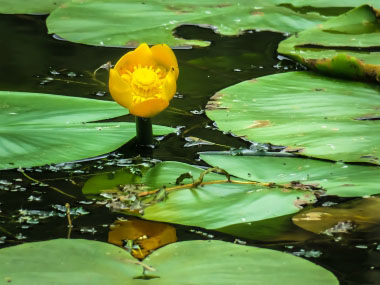

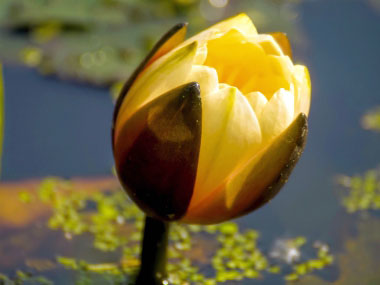
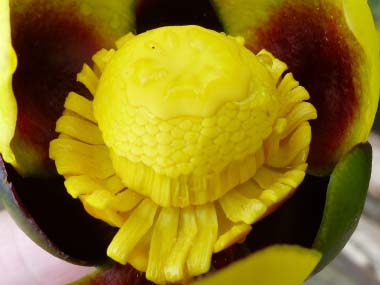
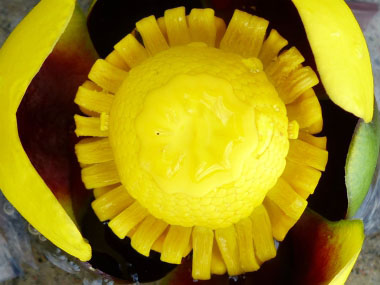
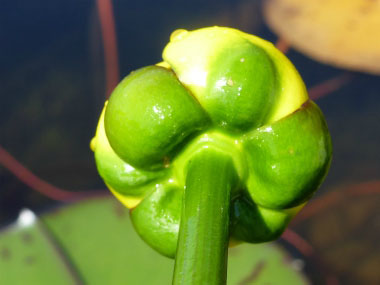
To support our efforts please browse our store (books with health benefits, etc.).
This perennial aquatic plant is native to North America, even in the colder regions of Canada's north and in Alaska. Yellow water lily is in the Nymphaeaceae (Water Lily) family. It prefers partly shaded locations in the water in which the soil conditions are (usually) loamy, sandy and even some clay. Some of its constituents include gallic acid (antioxidant), starch, tannins, and phytic acid (antioxidant). This common aquatic plant has a number of subspecies through the North American continent and other countries. This plant is also known as brandy-bottle or cow lily.
Distinguishing Features
The single, yellow, fleshy flower, with its prominent, lobed stigma is the best known feature. If you gather the rhizomes, they have a very distinct prehistoric look to them and feel spongy. This rhizome can get to 15cm wide and 5 metres long. The leaves and flowers are visible as they float on the water surface.
Flowers
This striking yellow flower occurs anywhere from March to October depending on geographical location. The flowers are waxy, cup-shaped and typically measure 4 to 6 cm (1.5 to 2.5”) across. The 4 to 6 yellowish-green sepals are much longer than the petals. The flower has 15 to 20 yellow petals, numerous stamens, and the stigma is shield-like and concave.
 Fields
of Nutrition has medicinal benefits and vitamin/mineral content of Yellow Water Lily.
Fields
of Nutrition has medicinal benefits and vitamin/mineral content of Yellow Water Lily.
Leaves
The leaves of this rhizomatous aquatic perennial are quite variable and may be wide or rather narrow and submersed or floating. They often measure 10 to 45cm long. The blade of the floating leaves are broadly elliptic to oval, light green, the stalk is angled. Submerged leaves are roundish and wrinkled. The leaf veins of yellow water-lily end at the blade margin and do not form a net-like pattern like those of white water-lily species.
Height
The yellow water lily grows to varying heights anywhere from 30 cm to 1 metre (1' to 3').
Habitat
This plant according to the USDA is found throughout Canada an the U.S. It typically is found in deep, slow moving or still water in waters that can be as deep as 3 metres (9'). They can occur in ponds, lakes, bayous, bogs, streams and springs.
Edible Parts
This was a common food source for many Native people. They would gather the thick rootstocks in winter and spring, boil or roast them for several hours, then peeled them to expose their sweet contents. Rootstocks were also sliced, dried and ground into meal or flour. The roots contain a relatively high level of tannins and it is best to try to leach the tannins before eating. (As a result of the bitterness, many people refer to the roots of this plant as survival food only.) Apparently the seeds when heated increase in size like poor-quality popcorn, making a crunchy snack. In small quantities, the roots, seeds and (cooked) leaves are considered edible by several sources. If you harvest this aquatic plant it is very important to be sure that the water source in which they grow is not contaminated in any way.
Other Name
Yellow Pond Lily.
Similar Plants
Spatterdock.
Winter Survival Food Handbook

PDF Plant Magazines
Types of Wild Food
Geographic Zones Seasons
Disclaimer
EdibleWildFood.com is informational in nature. While we strive to be 100% accurate, it is solely up to the reader to ensure proper plant identification. Some wild plants are poisonous or can have serious adverse health effects.
We are not health professionals, medical doctors, nor are we nutritionists. It is up to the reader to verify nutritional information and health benefits with qualified professionals for all edible plants listed in this web site. Please click here for more information.
Why Edible Wild Food?
- Food costs are rising
- Free, wild food is readily abundant
- Wild food adds nutrition to your diet
- Wild food can help treat various medical conditions







